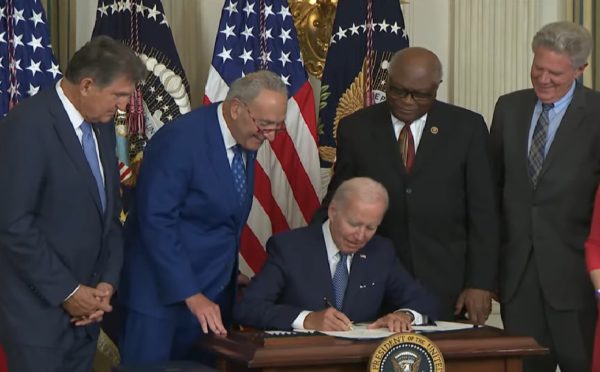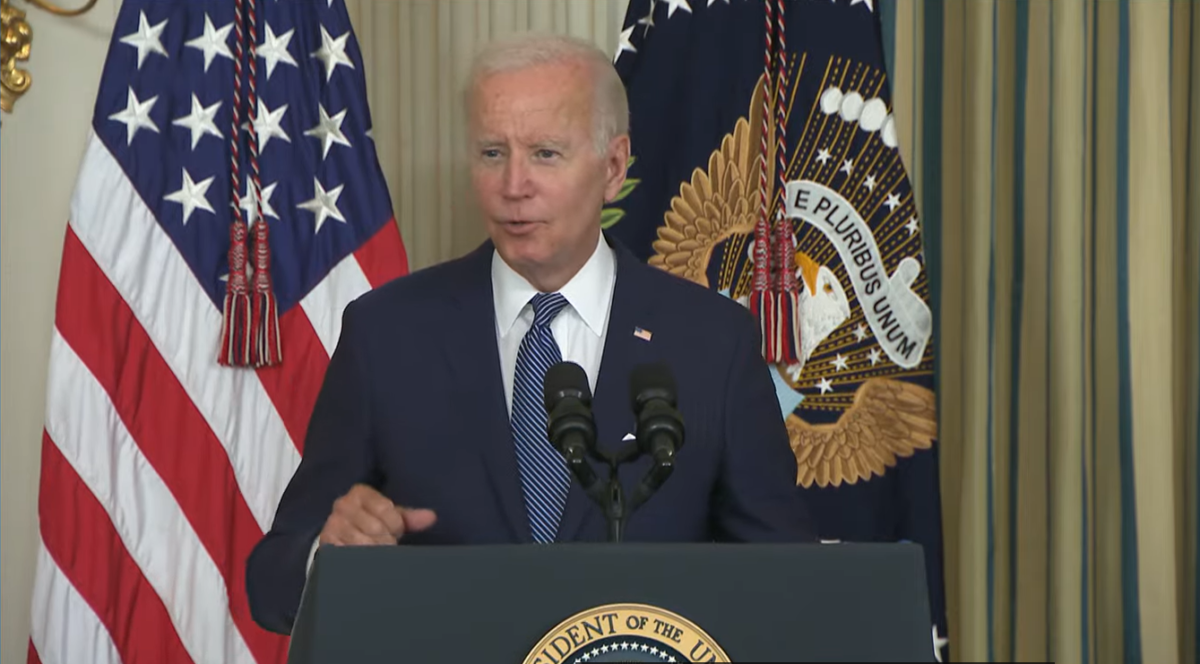President Joe Biden signed the Inflation Reduction Act (IRA) of 2022 into law, marking the largest climate and energy spending package in U.S. history. Inside the massive energy, climate, and tax bill is $600 billion in spending, $370 billion of which is dedicated to supporting renewable energy buildout and climate resilience.
The IRA mandates a nationwide reduction of carbon emissions by roughly 40% in 2030. The policy package is also aimed at creating energy savings for Americans. The Biden Administration said 7.5 million more families will be able install solar on their roofs with a 30% tax credit, saving families approximately $9,000 over the life of the system or at least $300 per year. Families that take advantage of clean energy, efficiency, and electric vehicle tax credits will save more than $1000 a year, said the administration.
The spending will be supported by closing tax loopholes on the wealthiest Americans and corporations. The administration said 55 of the largest corporations paid $0 in taxes in 2020, and the top 1% of earners are estimated to avoid $160 million in taxes each year. By closing tax loopholes and placing a 15% minimum tax on the largest, most profitable corporations, the IRA is expected to save the U.S. over $124 billion over the next 10 years.

Image: The White House
Image: White House
Solar energy is set to play a central role in the decarbonization and onshoring of U.S. energy. By 2030, it is estimated the IRA will lead to the installation of 950 million solar panels, 120,000 wind turbines, and 2,300 grid-scale battery plants.
“Americans can now rest assured that our leaders have acted to lower costs, strengthen American energy independence, and create hundreds of thousands of well-paid jobs, all while combatting the damaging impacts of climate change. With the President’s signature, the solar industry stands ready to invest in our domestic manufacturing capacity, grow the solar workforce, and rapidly scale our clean energy deployment efforts. I look forward to continued collaboration with our leaders to ensure a brighter, more sustainable future,” said George Hershman, CEO of SOLV Energy, a leading utility-scale solar developer.
A key to this buildout is the ten-year extension of the Investment Tax Credit at 30% for commercial and residential projects, including those installed in 2022. For larger solar projects, above 1 MW, the tax credit is default at 6%. To be eligible for the additional 24%, laborers and mechanics installing the solar power projects must be paid prevailing wages. There are 10% adders for having a specified amount of domestic content in a project, another 10% for siting projects in specified locations, and additional credits for clean energy production.
“What an historic moment for our country! Sunrun applauds everyone in Congress and the Biden Administration who helped accomplish this major step forward for humanity. The Inflation Reduction Act will combat inflation, lower energy prices and help our country meet its climate goals. It will boost U.S. manufacturing, create millions of good-paying jobs, expand access and equity for those who need it most, and improve grid stability and resilience,” said Mary Powell, CEO of Sunrun.
Domestic manufacturing provisions are central in this law. Production tax credits, roughly $30 billion, will be assigned to U.S. manufacturing of solar panels, wind turbines, batteries, and critical minerals processing. And, $10 billion in investment tax credits will be distributed for facilities that make EVs, wind turbines and solar panels.
The Defense Production Act holds $500 million for heat pumps and critical minerals processing, and $2 billion in grants will be used to improve existing auto manufacturing facilities to create clean vehicles like EVs and hybrids. Along with these funds, up to $20 billion will be available in clean vehicle manufacturing credits. About $2 billion will be given to national labs to accelerate breakthrough energy research.
“The passage of the Inflation Reduction Act by the U.S. House of Representatives is a victory for America. First, it represents a once-in-a-generation opportunity to achieve energy security and to ensure that the fight against climate change is powered by solar technology that represents American values and principles and is produced here, at home. Second, it’s an opportunity to ensure that the benefit of this groundbreaking legislation is shared, creating jobs and economic value where needed most. And finally, it will facilitate the cycles of innovation necessary to ensure our country’s leadership in clean energy technology, ensuring that the next generation of solar technologies is developed and made by America,” said Mark Widmar, CEO of First Solar.
As a result of the IRA, researchers from Princeton University, Dartmouth College, Evolved Energy Research and Climate Impact Consulting noted in the Rapid Energy Policy Evaluation and Analysis Toolkit (REPEAT) that solar deployment may accelerate from 2020 rates of 10 GW of capacity added per year to nearly five times as much by 2024, adding 49 GW of utility-scale solar each year. Solar deployment may be well over 100 GW per year by 2030, said the researchers.

Image: Princeton
Investment in solar could reach $321 billion in 2030, nearly double the figure of $177 billion expected under current policy. The Act would lead to nearly $3.5 trillion in cumulative capital investment in new American energy supply through the next decade, said the report.
Annual U.S. energy expenditures are expected to fall by at least 4% in 2030 under the act, a savings of nearly $50 billion dollars per year for households, businesses and the industry.
Full text of the law: H.R. 5376 – Inflation Reduction Act of 2022
This content is protected by copyright and may not be reused. If you want to cooperate with us and would like to reuse some of our content, please contact: editors@pv-magazine.com.









w00t!
Connecticut Solar Power would like to thank everyone who help make this possible! This has come in a time of need for this country.
Thank you
Robert A Trezza